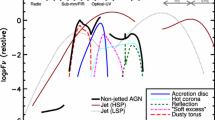Abstract
Young star clusters consisting of massive stars are the ideal sites to study the star formation processes and influence of massive stars on the subsequent star formation. NGC 1893 is a young star cluster associated with the Hii region Sh2-236. It contains about five ‘O’-type stars and several early ‘B’-type stars. It is located at a moderate distance of \(\sim \)3.25 kpc and has a reddening, \(E(B-V) \sim 0.4\) mag. To characterize the young low-mass stellar population in the central portion of the cluster, we carried out deep VI band observations of the region using the \(4\mathrm{K} \times 4\)K CCD IMAGER mounted on the 3.6-m Devasthal Optical Telescope. Our analysis shows that the present data are deep enough to detect stars below \(V\sim 24\) mag. We found optical counterparts of \(\sim \)220 candidates, including young stars and unclassified cluster members from Caramazza et al. (2008). We estimated the membership probabilities of the Gaia sources (mostly bright stars with \(G<19\) mag) located within the cluster radius using the Gaia EDR3. Toward the fainter end, we used the optical color-magnitude diagram (CMD) to select the cluster members from a sample of young stars. The locations of young stars on the CMD show that a majority of them are low-mass stars with age <10 Myr. The unclassified candidates and X-ray sources from Caramazza et al. (2012) are also found to be young low-mass stars. In total, we identified \(\sim \)425 young stars with age <10 Myr, and 110 of these are new. Most of these stars appear as kinematic members of the cluster. By examining the CMD for the stars in the cluster region, we suggest that the cluster has insignificant contamination due to field stars in the pre-main-sequence zone of the CMD. The slope of the mass function in the mass range \(0.2\le M/M_\odot \le 2.5\) is found to be \(\Gamma = -\,1.43 \pm 0.15\), consistent with those of other star-forming complexes. The spatial distribution of the young stars as a function of mass suggests that toward the cluster center, most of the stars are massive.






Similar content being viewed by others
References
André P. 1995, Ap&SS, 224, 29
Andersen M., Meyer M. R., Robberto M., Bergeron L. E., Reid N. 2011, A&A, 534, A10
Bate M. R. 2009, MNRAS, 392, 1363
Blitz L., Fich M., Stark A. A. 1982, ApJS, 49, 183
Caramazza M., Micela G., Prisinzano L., Rebull L., Sciortino S., Stauffer J. R. 2008, A&A, 488, 211
Caramazza M., et al. 2012, A&A, 539, A74
Chabrier G. 2003, PASP, 115, 763
Chabrier G. 2005, in Corbelli E., Palla F., Zinnecker H., eds, Astrophysics and Space Science Library, Vol. 327, The Initial Mass Function 50 Years Later. Springer, Dordrecht, p. 41
Damian B., Jose J., Samal M. R., Moraux E., Das S. R., Patra S. 2021, MNRAS, 504, 2557
Feigelson E. D., Montmerle T. 1999, ARA&A, 37, 363
Gaia Collaboration 2020, VizieR Online Data Catalog, I/350
Getman K. V., Feigelson E. D., Sicilia-Aguilar A., Broos P. S., Kuhn M. A., Garmire G. P. 2012, MNRAS, 426, 2917
Girard T. M., Grundy W. M., Lopez C. E., Van Altena W. F. 1989, AJ, 98, 227
Girardi L., et al. 2002, A&A, 391, 195
Kroupa P. 2002, Science, 295, 82
Kuhn M. A., Getman K. V., Feigelson E. D. 2015, ApJ, 802, 60
Kumar Ł A., Pandey S. B., Singh A.Ł. et al. 2021, arXiv:2111.13018
Lada C. J., Lada E. A. 2003, ARA&A, 41, 57
Lada C. J., Muench A. A., Luhman K. L., et al. 2006, AJ, 131, 1574
Lata et al. 2014, MNRAS, 442, 273
Lim B., Sung H., Kim J. S., Bessell M. S., Park B. G. 2014, MNRAS, 443, 454
Luhman K. L. 2012, ARA&A, 50, 65
Maheswar G., Sharma S., Biman J. M., Pandey A. K., Bhatt H. C. 2007, MNRAS, 379, 123
Marco A., Negueruela I. 2002, A&A, 393, 195
Ojha D. K., Tamura M., Nakajima Y., et al. 2009, ApJ, 693, 634
Pandey A. K., Samal M. R., Chauhan N., et al. 2013, New Astron., 19, 1
Pandey S. B., Yadav R. K. S., Nanjappa N., 2018, BSRSL, 87, 42
Pandey R., Sharma S., Panwar N., et al. 2020, ApJ, 891, 81
Panwar N., Samal M. R., Pandey A. K., et al. 2017, MNRAS, 468, 2684
Panwar N., Pandey A. K., Samal M. R., et al. 2018, AJ, 155, 44
Prisinzano L., Sanz-Forcada J., Micela G., et al. 2011, A&A, 527, 19
Salpeter E. E. 1955, ApJ, 121, 161
Sharma S., Pandey A. K., Ojha D. K., et al. 2007, MNRAS, 380, 1141
Siess L., Dufour E., Forestini M., 2000, A&A, 358, 5931
Stassun K. G., Torres G. 2021, ApJ, 907, 33
Yadav R. K. S., Sariya D. P., Sagar R. 2013, MNRAS, 430, 3350
Acknowledgments
The authors would like to thank the referee for the valuable comments that significantly improved the manuscript. Also thankful to the DTAC and staff of the 3.6-m DOT which is operated by ARIES. This work has made use of data from the European Space Agency (ESA) mission Gaia (https://www.cosmos.esa.int/gaia), processed by the Gaia Data Processing and Analysis Consortium (DPAC, https://www.cosmos.esa.int/web/gaia/dpac/consortium). Funding for the DPAC has been provided by national institutions, in particular, the institutions participating in the Gaia Multilateral Agreement.
Author information
Authors and Affiliations
Corresponding author
Additional information
This article is part of the Special Issue on “Astrophysical Jets and Observational Facilities: A National Perspective”.
Rights and permissions
About this article
Cite this article
PANWAR, N., KUMAR, A. & PANDEY, S.B. Deep V and I CCD photometry of young star cluster NGC 1893 with the 3.6m DOT. J Astrophys Astron 43, 7 (2022). https://doi.org/10.1007/s12036-021-09785-5
Received:
Accepted:
Published:
DOI: https://doi.org/10.1007/s12036-021-09785-5




